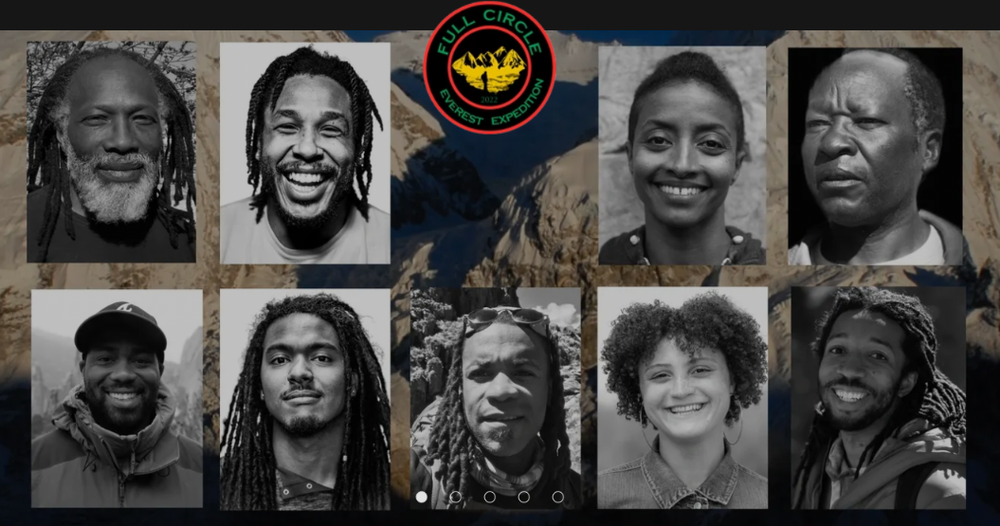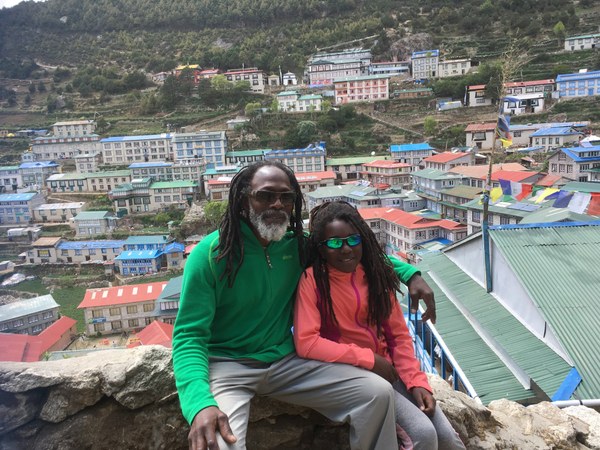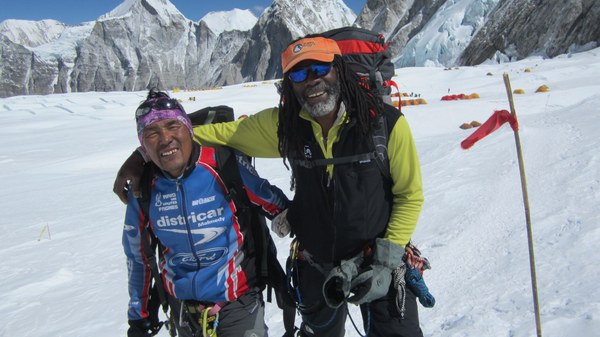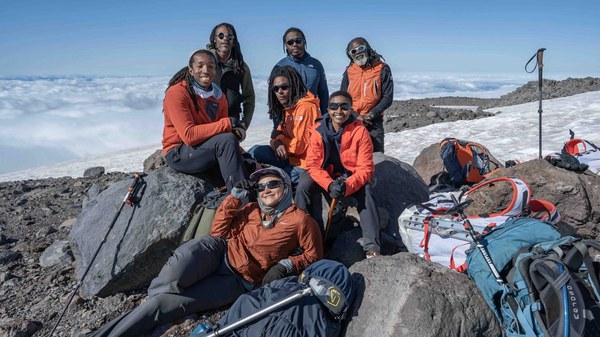
“Almost 60 years after the first successful American ascent of Mount Everest, a team of U.S. climbers aims to make history once again on the world’s highest peak. Led by Phil Henderson, a former instructor at the National Outdoor Leadership School and a veteran mountaineer, this group, made up of athletes from across the country, aspires to be the first all-Black American expedition to reach the summit.” wrote James Edward Mills, Mountaineers Books Author and freelance journalist, in an article for Outside Business Journal announcing the project in late August 2021.
“At a moment when much of the world is coming to grips with the glaring disparities of representation among people of color — in most human endeavors, not just outdoor sports—this remains one feat that Black Americans have yet to achieve… Set to begin in 2022, the team aims to create a supportive cultural environment that will encourage other people of color to dream of climbing big mountains.”
To learn more about Full Circle Everest, and how we can collectively support this groundbreaking expedition, we sat down for a chat with Expedition Leader Phil Henderson.
You’ve worked in the outdoor industry for a long time. How has your career brought you to create the first all-Black Everest Expedition?
I've been in the industry for 29 years. I was the first Black American instructor at NOLS – probably the first Black American employee – when I started back in 1994. When I look back at almost 30 years in the industry as an outdoor professional I've been to Denali twice, I've been to Kilimanjaro twice, and I ran the first Black American expedition there. I've been on Mount Kenya probably 16 times. I've done a lot of work with guides and porters in Kenya and Tanzania as well as volunteer work training high altitude workers with the Khumbu Climbing Center in Nepal, but people don't know who I am. Personally, I don't need that, but we don’t have room not to talk about ourselves anymore, by doing so we let history repeat itself. If we can change the storytellers then we can change the stories. We can make sure people don’t get left out.
Phil with a friend at Camp 1, Everest. All photos courtesy of Phil Henderson.
Black people have accomplished big things in the outdoor community. We are part of the climbing community already. We’re engrained there, but we’re still a very small population. For the most part, if you go to a climbing crag, if you go on an expedition, if you go to Denali, or on a NOLS or Outward Bound Course, it’s likely you're going to be the only person of color in that environment. We’re trying to give people an opportunity to not be the only person of color on an expedition. That's one of the things that I have always looked to change. I think that the industry is wanting to change that as well. This expedition not only inspires people of color but it’s also galvanizing for all people in our community.
Our fiscal sponsor is the Greening Youth Foundation. Back in the summer of 2019, they held their annual Legacy Camp Out. It's in Atlanta, Georgia, and it's held at the Martin Luther King National Historical Park. The biggest highlight I've had in my whole outdoor career was going there and doing a presentation to elementary school kids and their parents. After my talk, a young girl, maybe 10 or 11, came up with her mother and said, “Excuse me, sir. I have a question. What would you say to a young Black girl who wants to climb Mount Everest?”
That has held on really strongly with me in terms of inspiration. I'd like to be able to show a young person, especially a young person of color, that there are possibilities and opportunities out there – ones I didn't know existed when I was their age.
We chose Everest because it’s this iconic mountaineering goal that so many people seek. If we really want to talk about representation, we had to go big. We could all just get together and go to Mt. Rainier or Mt. Baker, but nobody would pay attention to that. And for the climbers on our team, this major step in their career is based on their skill level. They’re ready for Everest.
At this point, only nine or ten Black Americans have been on the mountain that we know of. We don’t actually even know the total number. We seek to almost double that in just this one expedition.
What’s the meaning behind the name Full Circle Everest?
Full Circle Expeditions actually started with a program called Beyond the Bricks back in 1999. I was talking to people back home in California about this outdoor stuff, and they're like, “Oh man, you do that? I want to do that!” So I invited them to come out to Wyoming to go backpacking. I've always been that way.
Full Circle is about giving forward; it’s about seeking people who have a passion for being outside and taking the experiences and the skills that we have and bringing that full circle and giving back to those people who are interested. That's what happened with me. When I came into the industry, I knew nothing. I knew no one who worked in the industry. But people reached forward and took me and said, Hey, let's go do this and let's go do that. Those experiences have given me that same attitude, and I want to pay that forward to younger people who haven't had those same opportunities.
It’s also about creating this circle of people of color who can raise that level of representation and inspire more people of color to get outdoors. And it doesn't stop at just people of color. At the heart of it, people are people, and in the bigger picture, we hope to inspire a lot of people to get outside and do things that maybe they didn't know they wanted to do, or know that they have a passion for, because they don't know folks who look like them doing these things. It's all about taking the experience and knowledge and skills that one person has and then transferring those to help someone else gain.
How did you go about identifying team members?
The team itself has come through relationships and happened because we’re at a point where we have these people who have the experience and skill and passion to go to Everest and climb that mountain.
I started volunteering for the Khumbu Climbing School back in 2006, working with Conrad Anker and a bunch of folks there. That really opened my eyes to the possibilities and other opportunities of international climbing. I had already lived in Kenya for a year and a half, but when I went to Nepal, it was a different story and it opened me up to Himalayan opportunities and culture. I think I've been to Nepal now nine times and I was on Everest in 2012, and in 2013 I moved to Patagonia, Chile for three years before coming back to the US in 2016.
During that period, somehow Conrad, Fred (Campbell), Manoah (Ainuu), and Demond (“Dom” Mullins) were connected. Before knowing that Fred and Conrad were connected, I actually ran into Fred at the Ouray Ice Festival. We just saw each other and talked about the Everest project. Fred sent me an email later and it was like, “I'd love to put this Everest expedition together.”
That’s how it started in 2019 with Fred and Manoah. Then I was looking at that team and thinking, who else can be on this team? I wasn't on Expedition Denali, but I was on the mountain at the same time [Expedition Denali was the first all African-American team to attempt Denali]. We shared 14 camp [a campsite at 14,000 feet on the standard climbing route], and the folks on the Expedition Denali team were in our camp quite often. I came back to the states in 2016, and it took me a couple of years to get reconnected. In 2018 I ran an expedition to Kilimanjaro for Outdoor Afro [ the first all Black American expedition to Kilimanjaro], and I wanted another female leader on that expedition. Rosemary Saal fit that bill. We've been on three continents together. And so when I looked for women for Everest, it was like, okay, Rosemary, I want her on this team. She's young, she's strong, she's passionate about being outdoors. She's a good educator and a ball of positive energy.
Eddie Taylor is another funny story. I was at a hotel in Ouray and I was walking my dog in the dog park and I ran into Eddie with his dog. We realized that we were both there to climb and we exchanged numbers. A month later in Bozeman, Eddie and Manoah got together and were climbing, and Manoah said he thought Eddie would be a good addition to the team. And maybe a week after that Eddie called me and said, let's get together and go skiing. So Eddie came out to Colorado, we spent a day skiing in the backcountry and just hanging out. I posed the project to him and he was like, “I'd love to be on board.”
We kept adding folks in that way. Having camaraderie is big. If you look at mountaineering, what really gets you through and helps you be successful on most projects is your partner and the relationship you have with your partner. We're building a group of people who have spent time together – who’ve climbed together and skied together. We see this as building a stronger community of people that can do things together. We hope that this opens a door to other opportunities for more Everest expeditions, or other expeditions for people of color.
Can you talk a little bit about how you're approaching training together?
A lot of it is about teamwork. When you're living together for two and a half months on Everest, you really need to be a team. We got together several times. The first time in Bozeman we went ice climbing and skiing. We stayed in a hut, and the initial trip was just to get the group together. Then we came to Rainier as a team-building trip and to gauge fitness level. We started hiking at night, 5,000 feet up to Camp Muir – we had a full moon. We were also the only ones out there, which was great.
The Full Circle Everest team on Mt. Rainier.
We would like to do a shake-down trip to Nepal with as many team members as possible in the fall. We want to connect with our support team so that they become members of our team. It also exposes other team members to the culture and the food so that when we go to Everest it’s not the first time they've been exposed to those things. We’d like to climb a 6,000 meter peak as well. I hope we can make that happen.
If our fall trip doesn't happen, we're looking at putting together a four or five-day trip for the team in the midwinter where we get together and just be cold. One of the most important things that you need to climb Everest is to be comfortable in the cold.
Training should peak somewhere in February or early March, and then a rest period before going to Nepal in late March/early April.
You spoke about building opportunities for people of color beyond this single expedition. Do you have any other hopes for life after Everest?
The expedition is not just about climbing. I want people to know more about us than the fact that we’re climbers. I'm a father, I'm a husband, and I have a 13-year-old daughter who I’ve taught to love life in the outdoors. I took my daughter to Nepal when she was four. She went back again when she was 11. And so to me, it's not just about climbing, but also about the global connection with the climbing community.
 Phil and his daughter Bahati at Namche Bazaar.
Phil and his daughter Bahati at Namche Bazaar.
I am almost 60, and not that people stop climbing or mountaineering at 60, but for me it really is time to start looking at my family and other things in life. Most of my career, this Black outdoor community didn't exist, and now it does. I have an opportunity to pass the torch as a mentor. That's what this expedition for me is about: supporting these other people on this trip that have goals for themselves, and have a super bright future in terms of climbing and mountaineering and outdoor education.
I’ve been working in the outdoor industry close to 30 years and because of the lack of representation, all of the opportunities that have come up for me have been by white people. I can’t say I don’t have mentors; I just don’t have mentors who look like me. I want everyone in this community regardless of what you look like. We all want to work together.
How can people support this groundbreaking expedition?
To secure our permits and support team, we need to raise $200,000 by September 15. It’s a big goal, but I believe it’s absolutely possible. We’re asking the community to amplify our expedition and provide financial support if you can. We’re also seeking opportunities to include science or environmental projects in our expedition. Though we are working our way towards fulfillment, we still have some gear needs... I’m grateful to Scarpa, who has already provided generous support.
You can learn more and spread the word from our website, fullcircleeverest.org, and through our GoFundMe page. You can also follow and amplify our story through Instagram. Every measure of support makes a big difference in creating opportunities for Black climbers and changing the narrative of who belongs in the outdoors.
 Kristina Ciari Tursi
Kristina Ciari Tursi

